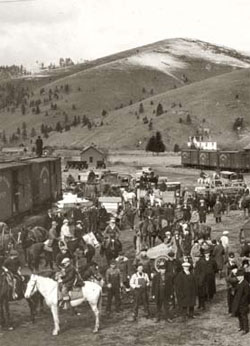Montana: Stories of the Land
Companion Website and Online Teacher's Guide
Chapter 15 - Progressive Montana, 1900-1924
Chapter 1 - Montana: Where the Land Writes History
Chapter 2 - People of the Dog Days
Chapter 3 - From Dog Days to Horse Warriors
Chapter 4 - Newcomers Explore the Region
Chapter 5 - Beaver, Bison, and Black Robes
Chapter 6 - Montana's Gold and Silver Boom
Chapter 7 - Two Worlds Collide
Chapter 8 - Livestock and the Open Range
Chapter 9 - Railroads Link Montana to the Nation
Chapter 10 - Politics and the Copper Kings
Chapter 11 - The Early Reservation Years
Chapter 12 - Logging in the "High Lonesome"
Chapter 13 - Homesteading This Dry Land
Chapter 14 - Towns Have Lives, Too
Chapter 15 - Progressive Montana
Chapter 16 - Montana and World War I
Chapter 17 - Montanans on the Move
Chapter 18 - The Great Depression Transforms Montana
Chapter 19 - World War II in Montana
Chapter 20 - Building a New Montana
Chapter 21 - A People's Constitution
Chapter 22 - Living in a New Montana
Learning From Historical Documents
Letter from Jeannette Rankin to Anna Shaw, quoted in the Montana Good Government State Central Committee records, 1895-1919. Small Collection 567. Montana Historical Society Research Center. Archives. Excerpted in Not In Precious Metals Alone: A Manuscript History of Montana (Helena, 1976): 235.
Context for Jeannette Rankin's Letter:
When, after a long struggle, Montana women won the right to vote in 1914, part of their victory could be attributed to the Progressive crusade to make political institutions more representative. However, credit was also due to the dedicated campaigners who visited every part of the state. One of the lead organizers of the suffrage campaign was Jeannette Rankin, who formed a sophisticated organization that marshaled a host of committed volunteers. During the campaign, Rankin reported on the progress to Anna Howard Shaw, president of the National American Women's Suffrage Association. Although suffragists (and their opponents) declared that women would reform and/or vastly change politics, women as members of the electorate actually altered the character of Montana politics very little.
About Primary Sources:
Letters, diary entries, census records, newspapers, and photographs are all examples of "primary sources," material created at a particular moment in the past that has survived into the present. Primary sources can provide clues to the past. They are our windows into an earlier time. The Montana Historical Society contains thousands of primary sources. In the 1970s, archivists collected just a few snippets into a book, which they called Not in Precious Metals Alone: A Manuscript History of Montana. That book is now on the web in its entirety. The above sample from that book relates directly to this chapter.


